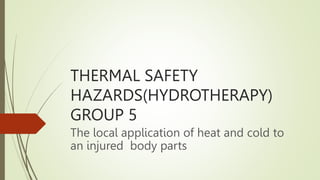Hydrotherapy.ppt
- 1. THERMAL SAFETY HAZARDS(HYDROTHERAPY) GROUP 5 The local application of heat and cold to an injured body parts
- 2. WARMING THERAPY/TREATMENT ?A treatment of warm water given to people with core temperature(below 34.5?c). ?Warm water is used because it is a vasodilator, it expands blood vessels thus improving blood circulation.
- 3. OBJECTIVE ?To raise temperature gradually to (0.5-1?c) to normal, restore breathing, cardiac function and fluid and electrolyte balance, renal function and blood sugar to normal.
- 4. SIGNS OF HYPOTHERMIA ?Slowing temperature ?Confusion ?Slow irregular respiration ?Arrhythmic, feeble pulse leading to cardiopulmonary arrest. ?Pupils become widely dilated and fixed.
- 5. TREATMENT ?Wet clothing is removed and patient covered. ?Patient is moved to a place where rewarming and pulmonary resuscitation can be started. ?The apnoeic or hypoventilation patient requires intermittent positive pressure ventilation, and intravenous therapy as soon as the rewarming has started.
- 6. Four ways of rewarming the hypothermic patient 1.Spontaneous rewarming in the mildly hypothermic patient, if he is able to generate heat metabolically. 2.Active external rewarming by wrapping heated(preferably electrical) blanket around a patient.
- 7. a. Administering heated intravenous fluids. b. And heated,humidified oxygen Even though this is effective, it may have drawbacks such as: i. Causing hypotension in a patient who is also hypovolaemic ii. It may cause drop in core temperature. Rewarming by immersion in heated water.
- 8. HYDROTHERAPY IN RHEMATOID ARTHRITIS OBJECTIVE a) To exercise the patient without pain or stress on the mass-bearing joints because of buoyancy of water. b) For pain relief through heat of water.
- 9. PROCEDURE ?A good gymnasium is equipped with a heated water ?The buoyancy of water enables immersed patient to walk without stress. ?Exercises of affected joints are done in water
- 10. Hydrotherapy with warm water in case of burns Objectives: ?For debridement of burns. Blisters can be broken and dead tissues are removed ?For soaking off old dressing ?To allow for exercise of painful limbs
- 11. Local heat treatment and therapeutic warm baths Objectives: ?Relieve pain
- 12. Application of contact heating appliances ?Hot water bottle is used to provide the body with heat Usually made of rubber of plastics Direction for use ?It should be tested for leakage first ?It should be placed in cover between blankets.
- 13. Rules for filling hot water bottle ?Place the bottle on flat surface and fill it to ? capacity with nearly boiling water. ?The stopper is screwed on, and test for leakage ?When it is dried, place it in a cover and use.
- 14. Electrical pad ?It is used for the same purpose as hot water bottle, but here the can be regulated and kept constant. ? ensures that the cords are still insulated.
- 15. Infra- red radiation ?The infra-red rays are the invisible heat rays which are emitted by a special lamp or an electric cradle with bulbs.
- 16. objectives ?To relieve pain ?To encourage hyperaemia inan inflamed, infected area. ?To dry a soggy wound, e.e perineal sticthes
- 17. Therapeutic warm baths ?Warm baths are useful for loosening dressings or removing sloughs and pus from septic wounds. ?It can be done through arm and foot bathe or a basin. ?Aseptic precautions should be used if the local warm bath (basin) is used for raw wound.
- 18. cleaning and disinfecting of the bath ?After thourough cleansing, Wipe with activated cidex or hibicol, using a clean mop to disinfect.
- 19. The sitz bath ?This is a warm, shallow bath that cleanses the perinieum, which is the space between the rectum and vulva or scrotum. ?The sitz baths are used as a routine after anal operations. ?Also used for easing pain of pelvic inflammatory conditions.
- 20. Types of bath water ?Clean warm water to allieviate pain. ?Antiseptic bath after anal or vulva operations. E.g povidone- iodine ?1kg of clean fine table salt for a half filled bath containing 120 litres of warm water.



















